Part 2 of 2. A long trip report detailing our time climbing in the Fitz Roy massif, Patagonia. You should read part one here first: https://www.ubc-voc.com/2023/10/03/a-first-foray-in-patagonia-pt-1
January 30-31: Mermoz misadventure
We hiked back up to Piedra Negra, swapping our approach shoes and light packs, for the mountaineering boots, crampons, and heavy packs we had stashed near the glacier below Paso del Cuadrado. We ascended the pass and dropped down the other side to the Glaciar Fitz Roy Norte, where we constructed a fine bivy under a boulder. I found an old, make-shift aluminum piton amongst some debris and wondered if the ever-present rockfall had brought it down from the walls high above.
Our plan was to climb the long, but fairly easy Filo Noroeste (6a, 1000m). Bivying somewhere half way up the northwest ridge, summit the next day, then descend via the glacier on the other side. Except for the necessary crampons, ice tool, and mountaineering boots – we went very light on gear.
We woke at 03:00 and set forth after a quick breakfast. We spent some time navigating around the broken ice and crevasses along the edge of the glacier until we were fairly confident we had reached the base of the route. Initial inspection of the walls revealed that every crack and corner was seeping with water or thinly veneered with ice. Puzzled, we took out the stove to brew up while pondering the next move, until dawn broke. We settled on a revised plan to try an alternative start to the route that was vaguely described as “going up some slabs” that were about 500m back toward our bivy. In the burgeoning daylight we identified a feasible route up the slabs, and quested off simul-climbing on numb toes.
Massively runout – careful foot placements dodged wet rock as I breached the top of a large, friable dihedral 300m above. Though the climbing was easy, the other factors certainly added some alpine spice. At the base of the Northwest ridge proper, we paused briefly to luxuriate in our first rays of direct sunlight and gazed up at a tricky looking section of climbing. Laden with a heavy pack, Nick made a tentative foray up the steep ridgeline, but soon downclimbed again. We quickly realized that 800m of this kind of climbing would be pushing too close to our limits with heavy overnight packs. Now late morning, Nick and I were well behind our desired timeline. We agreed that it was in our best interests to bail. Not such an easy task from our current position.
We were forced to scurry across the high basin below Mermoz’s west face, threatened by a menacing serac. The sun climbed. The sooner we could get this done, the better. On the other side of the basin we happened across a bivy cave that had been excavated between two contiguous boulders, and it dawned on us that perhaps all was not lost. Still with plenty of food and all the equipment needed for a route on Mermoz west face. So we made ourselves comfortable in the bivy cave and settled in for another alpine start.
Perhaps two hours later a group of climbers returned to our bivy cave having climbed the same route we were planning for. We chatted briefly and confirmed that conditions were good and their ascent had gone relatively smoothly. They were now deliberating whether to descend all the way to basecamp or spend another night with us in the bivy cave. There was some commotion from their VHF radio – something about a helicopter evac. In the midst of their discussion – “ROCK!!!” – an absolutely massive torrent of rock and ice barrelled off from somewhere on the face above us. Debris roared past into the basin, perhaps 80 meters away, as we cautiously peered out from our shelter. It became apparent that we were not directly in the line of fire. We all exchanged looks of tentative relief. A thick cloud of debris smoke blew in with the smell of gunpowder. It didn’t take long for the other climbers to agree on heading back to basecamp that night. Already situated in the only sheltered bivy around, we nervously eased back into our bags and eventually found sleep.
Short video of some big alpine movement 80ish meters away [dropbox link]
February 1: Argentine (6a+, 600m), Aguja Mermoz, as told by Nick Brown
The next morning we woke at 04:00 and set out at daybreak. It was even colder than the previous morning and I could scarcely fathom taking off a single layer of clothing, including my big puffy jacket. We climbed quickly through the first pitches of the route–a series of easy but frozen ramps. I had a hard time remembering my motivations for alpine climbing as my frozen toes plunged into snow and my frozen fingers fumbled in icy cracks. We continued this grim work into steeper pitches but I stayed cold. I couldn’t bear the thought of removing my one warm layer of clothing, so I led up a section of offwidth crack that widened to a chimney while wearing my puffy. “I F***ING hate this pitch!!!” I yelled down to Nick several times while grovelling in the snowy chimney, seeing nowhere to put in any protection and thereby pause my misery. Through a stream of cursing and frustrated squirming, hand jams in snow and body jams against my poor camera, I finally overcame the awkward section and finished my pitch. I was in a damn foul mood until I discovered that my camera and puffy were both intact. However, it wasn’t for another two hours when we finally reached the ridgecrest and felt direct sunlight that my spirits returned to a more moderate level.
We reached the summit of Mermoz around 15:30; half an hour later than our turn-around time, but we felt the exception was minor and justified to reach such a fantastic summit. Thereafter began the urgent but careful work of rappelling all the way back to the base of the mountain. We worked our way through innumerable rappels along the convoluted ridgeline, giving voice to our relief each time we pulled the rope and it did not snag high above us. We made double rope raps down the northwest face, taking exceptional care to discuss and plan each rope pull to ensure the best chances of retrieving our precious cord. The need for extreme caution was highlighted by the graveyard of old tattered and severed ropes tracing the upper half of this West face descent line. At the base of one of our final rappels, I pulled the ropes but this time the tail got stuck. Properly stuck. Nick and I discussed our options quickly: either we climb back up two pitches on unknown terrain, or we cut the rope and descend with our remaining rope. It was by now almost 20:00 and we intended to travel all the way back to basecamp that night to avoid a windstorm we understood would arrive after dark. I decisively took the knife from Nick and severed my beautiful new rope at the halfway mark. We left it dangling unceremoniously in the rising winds and finished our descent.
Bivy boulder at 21:00; quick pack-up; race off to find the descent before dark. We had little specific information about the route over the high col to basecamp other than that it follows “300 metres of fixed line across slabs”. So we went to where the distance seemed shortest between the slabs and the high col, but found no evidence of fixed lines anywhere. We scampered up and down and eventually found a rock cairn way up above the zone we expected to travel through. It was now fully dark and we could find no further trail markers or signs of other climbers. Reluctantly, we agreed to surf out the wind storm from our boulder bivy and figure out the route back to basecamp in the morning.
Oh and we surfed. Strong winds whipped up just as we made it back to our bivy, and by the time we had unpacked our sleeping gear and settled in, all hell broke loose.Winds blasted into our shelter, occasionally with enough force to lift my legs entirely off the ground, threatening to steal my sleeping pad from underneath me and ferry it into the void. We zippered our bivy bags fully shut and steeled ourselves against the fury. All night and through the early morning, steady bursts of wind siphoned into the cave, billowing our bivy bags so violently that it was impossible to sleep or even relax (although Nick later told me that he somehow managed some sleep amid all this). I focused on simply enduring the discomfort as well as I could, and brought my full force of will to bare as the torment dragged on. Around maybe 07:00, the winds abated enough that my exhaustion was finally overpowering enough to afford me some sleep.
February 2: The Fixed Ropes
Small snow drifts had built up around the bivy cave when we awoke around 09:30. We finished our post-poned dinner of the previous night and set off within an hour. As it turned out, the fixed ropes were the final step on long and convoluted journey around the basin that would have been impossible to happen upon in the dark. Negotiating the transition from a melting tongue of snow onto the polished rock slab demanded some tricky climbing moves – wearing mountain boots and carrying an ice axe in one hand. First time I’ve ever actually had to use a boot-axe belay. We would later learn that the party before us was able to walk straight from the snow to the fixed lines; i.e., the snow tongue had melted ~10m in the one day between their passage and ours. The fixed ropes themselves are ratty mess of old climbing rope that loosely guides you across the slabs. I’m very glad we didn’t attempt to navigate this blindly in the dark as yesterday’s storm started to whip up. It took us about 3h from our bivy back to the cache at Piedra Negra. Nick and I packed up the rest of our supplies and hiked straight down to the road, where we hitched a ride back to El Chaltén.
We arrived back at the hostel and were met hugs and a sigh of relief from friends there. We quickly learned that the earlier emergency chatter overheard on the VHF radio had concerned a new friend of ours from the hostel. Marcos Gorostiaga, a 28-year-old Argentinian climber, had been killed by rockfall two days earlier. The mood at the hostel was deeply sombre. The high of our previous few days quickly faded as we settled back into reality. The recent loss instilled a looming feeling that maybe we had just ‘gotten away with something’, while others did not.
February 3 – 4: Downtime and Departure
The mood at the hostel gradually picked up again, despite the weather in the mountains deteriorating. I think everyone was glad to have a bit of forced downtime. Several friends from the hostel shared February 4 as their departure date, thus another Argentinian Asado was in order. It was a fine send-off, and many climbers from around town congregated at Hugo’s Hostel that evening.
After a round of goodbyes at the hostel, I embarked on the ubiquitous El Chaltén commute – plodding across town to the bus station with a heavy pack, a duffel bag over my shoulders, and the word ‘gringo’ stamped across my forehead. Or I may as well have, anyway. I was glad to share a few legs of the long journey home with a fellow climber from Hugo’s – his AirMiles deals facilitated good eating and Bloody Marys at each airport as far as the Denver, CO.
Final thoughts:
Patagonia’s Fitz Roy Range is one of those places that is on the radar very early for any involved alpine climber. It sits on a high pedestal – a proving grounds that demands the culmination of many years of skill development in the mountains. At least this is how I felt. Following this trip, I’ve been asked often; “Do you think you’ll go back?”
Frankly, the answer is probably not – not any time soon. Undoubtedly, it’s a beautiful place with an amazing community, and I’d be tempted to return and spend a season for these reasons alone. But, living in Vancouver, it is a long way away. I wouldn’t say it is necessarily somewhere that every climber should feel like they need to go. It is also undoubtedly a dangerous place. The topography and climate means the rockfall is no joke, and sometimes it’s bigger than any reasonable decision making within your power. We are spoilt in BC that you really don’t need to travel that far to find grand adventure. Personally, I’m looking forward to spending the next few years fixated on BC’s wild Coast Mountains.
—————————–
Misc. Beta:
Blue Dollar: As of writing this, Argentinian Pesos are, unfortunately, not a reliable currency. Bring USD, preferable crisp $100 bills – you’ll get the best exchange rate for pesos this way. Don’t exchange much at the airport – you’ll get a much better rate from people on the street corner in touristy areas. People want your USD. Paying attention to this will make your trip 40% cheaper.
Flights: I hate airlines.
Transport: Busses are the usual way to get across town or country. A smart person might want to book everything long in advance. This is not me. If you don’t want to be locked into something, medium proactively once you get there and suss things out will still serve you well. You may sometimes get charged the gringo rate though.
Accommodation: Can be the crux of the stay in El Chalten. Find somewhere you can book ahead, but preferably pay in cash when you get there. I went to Chaltén with very little plan and got away with it by camping in someones yard. It works but maybe I wouldn’t recommend it.
Gear: If you have extra gear; bring it, and sell to the locals for cheap. Climbing gear is very hard to get in Argentina (tariffs + bad exchange rate…). Generally, Argentinians are still looking for ‘good deals’ by Canadian standards. If you want to sell your gear in Argentina below Canadian market rate (which is too high anyway), you would be a good person. With some searching, you can find Isobutane in El Chaltén,
Food: This will take a bit of figuring out. It will take more time than you expect. It is hard to find calorie dense food, even in a touristy mountain town like El Chaltén. It would not be unreasonable to bring a large box of Clif Bars down there – you might even save money (and definitely time searching grocery stores). Mantecol bars are good, if you can find them.
Town: On weather days, you may devote the whole day to walking around town, going to different stores to see what they have food-wise. It’s just part of the rest day routine. There is no ‘one-stop-shop’ in El Chaltén. You spend a long time walking back and forth across town. I would maybe bring a small pennyboard down next time.
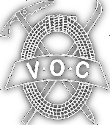
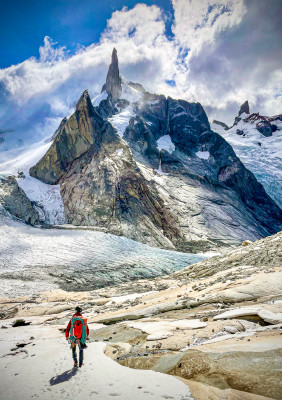
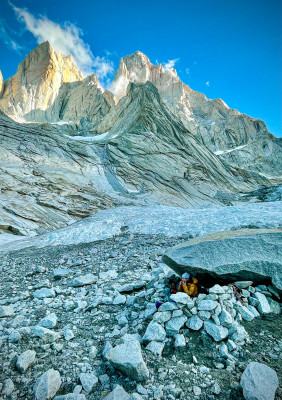
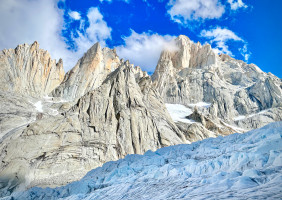
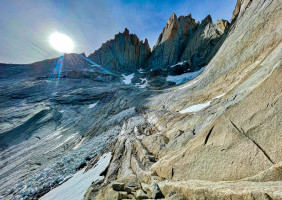
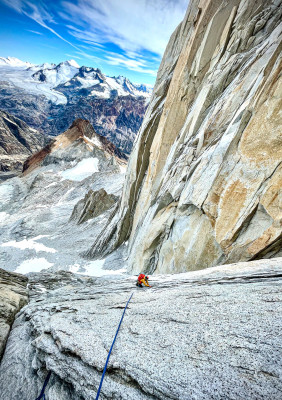
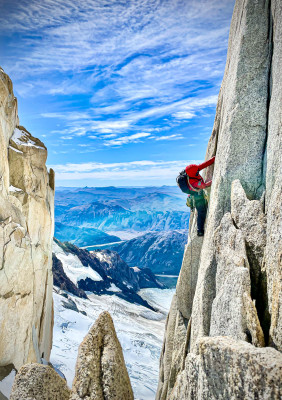
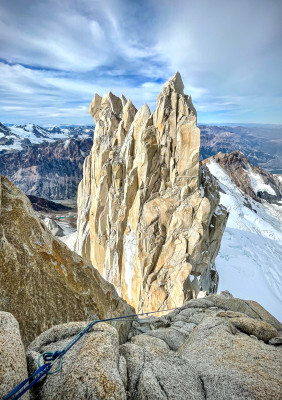
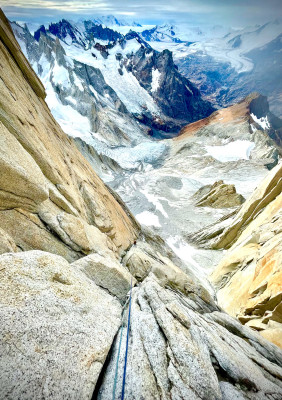
It’s as beautiful as I imagined! I’m glad you guys made it back safe and got some sick climbing in!